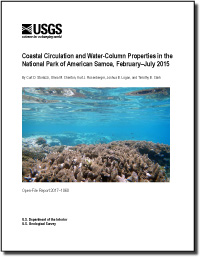Coastal circulation and water-column properties in the National Park of American Samoa, February–July 2015
Links
- Document: Report (6.3 MB pdf)
- Data Release: USGS data release - Data from coastal circulation and water-column properties in the National Park of American Samoa, February–July 2015
- Download citation as: RIS | Dublin Core
Abstract
There is little information on the oceanography in the National Park of American Samoa (NPSA). The transport pathways for potentially harmful constituents of land-derived runoff, as well as larvae and other planktonic organisms, are driven by nearshore circulation patterns. To evaluate the processes affecting coral reef ecosystem health, it is first necessary to understand the oceanographic processes driving nearshore circulation, residence times, exposure rates, and transport pathways. Information on how the NPSA’s natural resources may be affected by anthropogenic sources of pollution, sediment runoff, larval transport, or modifications to the marine protected areas is critical to NPSA resource managers for understanding and ultimately managing coastal and marine resources. To address this need, U.S. Geological Survey and U.S. National Park Service researchers conducted a collaborative study in 2015 to determine coastal circulation patterns and water-column properties along north-central Tutuila, American Samoa, in an area focused on NPSA’s Tutuila Unit and its coral reef ecosystem. The continuous measurements of waves, currents, tides, and water-column properties from these instrument deployments over 150 days, coupled with available meteorological measurements of wind and rainfall, provide information on nearshore circulation and the variability in these hydrodynamic properties for NPSA’s Tutuila Unit. In general, circulation was strongly driven by regional winds at longer (greater than day) timescales and by tides at shorter (less than day) timescales. Flows were primarily directed along shore, with current speeds faster offshore to the north and slower closer to shore, especially in embayments. Water-column properties exhibit strong seasonality coupled to the shift from non-trade wind season to trade wind season. During the non-trade wind season that was characterized by variable winds and larger waves in the NPSA, waters were warmer, slightly more saline, relatively less optically clear, and more stratified. When winds shifted to a more consistent trade wind pattern in the austral fall, the waters cooled and became less stratified because of decreased insolation. There are consistent spatial patterns in water column characteristics—Waters were warmer and less saline near the surface and closer to shore, especially in embayments, which tended to be more turbid, less clear, and characterized by higher chlorophyll than waters offshore. Water residence times were shorter farther offshore and longer closer to shore and in embayments, but varied spatially because of different forcing. Warmer, lower salinity, higher chlorophyll, and more turbid waters in embayments tend to reside in those locations for much greater durations, resulting in greater exposure of embayment ecosystems to those waters. This is in contrast with waters farther offshore, where the combination of shorter residence times and cooler, higher salinity water results in less exposure to land runoff. Understanding coastal circulation patterns and water-column properties in NPSA’s waters along north-central Tutuila may help to better understand how meteorological and oceanographic processes, at the regional and local scale, affect coral reef health and sustainability in this region.
Suggested Citation
Storlazzi, C.D., Cheriton, O.M., Rosenberger, K.J., Logan, J.B., and Clark, T.B., 2017, Coastal circulation and water-column properties in the National Park of American Samoa, February–July 2015: U.S. Geological Survey Open-File Report 2017–1060, 104 p., https://doi.org/10.3133/ofr20171060.
ISSN: 2331-1258 (online)
Study Area
Table of Contents
- Abstract
- Introduction
- Operations
- Data Acquisition and Quality
- Results
- Discussion
- Conclusions
- Acknowledgments
- References Cited
- Additional Digital Information
- Direct Contact Information
- Appendix 1. Acoustic Doppler Current Profiler (ADCP) Information
- Appendix 2. Temperature Logger (TL) and Conductivity and Temperature (CT) Sensor Information
- Appendix 3. Water Column Profiler (WCP) Information
- Appendix 4. Water Column Profiler Log
- Appendix 5. Internal Tide Schematic
- Appendix 6. Time-Series Data from Mooring Sites
- Appendix 7. Spatial Wind Data from the Vessel-Mounted ADCP (VM-ADCP) Surveys
- Appendix 8. Time-Series Data from Mooring Sites During the Vessel-Mounted ADCP (VM-ADCP) Surveys
- Appendix 9. Spatial Current Data from the Vessel-Mounted ADCP (VM-ADCP) Surveys
- Appendix 10. Lagrangian Surface Current Drifter (LSCD) Data
- Appendix 11. Water Column Profiler Data
| Publication type | Report |
|---|---|
| Publication Subtype | USGS Numbered Series |
| Title | Coastal circulation and water-column properties in the National Park of American Samoa, February–July 2015 |
| Series title | Open-File Report |
| Series number | 2017-1060 |
| DOI | 10.3133/ofr20171060 |
| Publication Date | June 06, 2017 |
| Year Published | 2017 |
| Language | English |
| Publisher | U.S. Geological Survey |
| Publisher location | Reston, VA |
| Contributing office(s) | Pacific Coastal and Marine Science Center |
| Description | Report: ix, 104 p.; Data Release |
| Other Geospatial | National Park of American Samoa |
| Online Only (Y/N) | Y |


